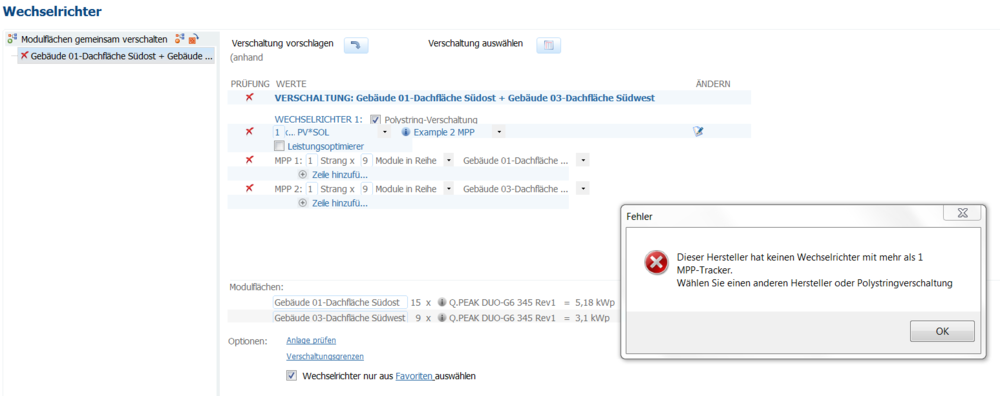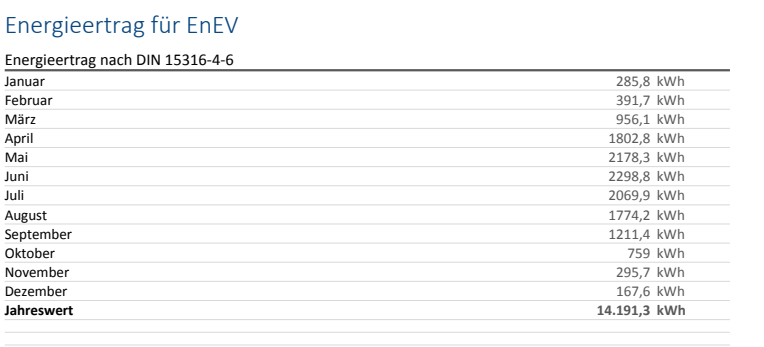

Vishnu
Members-
Posts
70 -
Joined
-
Last visited
-
Days Won
9
Everything posted by Vishnu
-
Hello Valentin Team, We simulated a projekt a couple of months back and ended up with 909 kWh/kWp Spez. Jahresertrag. But when i re-run the same simulation today, to my surprise, it increased to 929 kWh/kWp. I know year 2020 has been crazy but is it really this crazy!!!??? ?? Tja, i checked the energy balance results and i could see significant difference in multiple sections. Could you please help me understand why there is a difference here? Do you think it is because of some updates you have made or am i missing something that's changed in my simulation? I would be happy to send you the simulation file and the older pdf report in private message. Sorry i don't have 2 different pvsol files, it's the same file that i re-ran VG, Vishnu
-
I am not sure about diffused radiation model but it is a good pratice to activate minute values when DC/AC ratio is above 1,15 and with batteries. It almost takes forever for the simulation but still
-
Hallo Valentin Team, Hope you all are enjoying the summer !! Apparently, zero grid injection systems are performing pretty bad, especially in case of unbalanced loads. We have a system performing worse than what we expected from simulations. Our theory is that this could be becasue of unbalanced load distribution on the phases where one of the phases has very low consumption which is consequently limiting the generation as the inverter has balanced output on all its phases I simulated with curtailment at feed-in point but this did not help us in preparing for what's about to come. Is there any way to make our simulations reflect such scenarios in the future? Of course, we did not use the customer's actual consumption profile in the simulations. Do you think that would have made the difference? Please see the gap between consumption and generation values in the attached pic. There is always a huge buffer between consumption and generation to ensure zero grid feed-in Grüße, Vishnu
-
Hello again, Are you people already enjoying yourselves as restrictions are being removed in Berlin?? ? So, we are planning a system with two SolarEdge inverters(SE10K + SE7K) and want to add two batteries (2*LG Chem 10). PVSol currently allows me to add two batteries only to one inverter. Of course, we would use hybrid inverters Could you please let me know if there is a way to add one battery to each inverter? Thank you,
-
Dear Martin, Thank you for your reply. I have checked with the WR manufacturer regarding the usage of high power modules. I was told that the inverter clips any current and power over the rated values and the input voltage should not exceed the rated-voltage (attached the screenshot) I have checked Uoc of Qcells 340/345 Wp modules (40,24/40,49 Volt). So I understood that these can be used with this WR which has rated input voltage 42V but PVSol throws an error as Impp of the modules is more than rated current of WR (9,52A) Could you please suggest what can be done to use 340/345Wp modules with this inverter? Is it a good idea to change the rated the input current of WR (we added the WR manually). Thank you for your inputs - Vishnu
-
Hallo Team, Hope you people are safe and doing good. I guess you people are based out of Berlin, aren't you? Berlin is still safe (I'm in Berlin too) I haven't checked the forum for sometime now. Apparently a lot happened ever since ? We added AEConversion AE INV315-50 to PVSol manually and the datasheet says recommended modules 290-340W Of course 340Wp modules hardly generates 340W in actual conditions and therefore the max output current from module (10,16A) is hard to achieve The allowed max input current to inverter is 9,5A. So when we tried to use 340Wp module along with this mikro-WR, PVSol doesn't allow it. Here comes multiple questions 1. How can one decide whether or not one can use 340Wp module for this WR. Because if the WR is damaged, the Garantie can't be claimed. So the desinger needs to know if the max power of module can ever be achieved given the inclination and orientation of the module (which of course changes with project) 2. Generally we know that there is power clipping when module is generation more than rated input WR power. So does this clipping also limits the input current? Sorry if i am asking funny questions. Thank you!!
-
Hey there, I can think of one way which might help you here. As there is nothing you can earn from feeding into the grid, you can simply set the feed-in regulation to 100% at the feed-in point. This setting allows the system to act as zero grid injection system. (All that excess energy after self-consumption is down regulated at the feed in point) Did i answer your question?
-
Adding to what Martin explained, from what i know, optimizers work on the principle of Festspannung (fixed voltage, not sure if that's the right word) so no matter what the module output voltage is (which depends on radiation it receives), the optimizers make sure that their output to the string is always at fixed voltage. This helps the MPPT and hence higher energy output. From this I would say, optimizers help in case of partial shading/multiple orientations/non uniform shading on modules in same string.
-
Interesting results. I personally ran simulations for some of our systems with and without optimizers to check if they are really useful. My experience is that, in our systems, it completely depends on the system itself. There is no one clear argument. In case of east-west or partial shaded systems, when modules in east and west are connected in series on the same string, there is a significant difference in yield in systems with and without optimizers. Systems with optimizers are better performing. In cases, where there is negligible shading, say 2-4% on an average, and with inclination close to optimial value (for example: around 25-30 degrees in case of Germany), the system with optimizers has inferior performace compared to the one without optimizers. Reason is conversion losses in the optimizers. I would love to see the explanation for your query where there is complete shading
-
Hey Martin, I remember that NEC requries rating the breakers at 125% the full load current. Please correct me if I am wrong. Is it different in case of PV systems when it comes to breakers for inverters? Danke!!! -Vishnu
-
Hallo PVSol Team, I was wondering how PVSol calculates the rating of circuit breakers needed after the inverter and after the bidirectional meter for a system. z.B. the following system uses Solaredge SE7K 3 phase inverter with max output current per phase of 11,5 Amp. PVSol suggested a 16A breaker. Could you please explain how this suggestion was made? Thanks.
-
hey Kenn, do you mean "how to calculate the losses due to soiling"? You can see the %loss due to soiling on modules in "Simulation" option.
-
Hey Dev Team, We have recently installed a PV system and the customer would like to install a battery system in the next 2-3 years. He would like know how his existing cash flow would change upon adding a battery after 3 years. Is it possible to add investment to the existing cashflow for the 3rd year after commissioning ? Thank you!!
-
Adding to it.. I now removed modules from one building. so i now have modules on two buildings and upon selecting e3dc, the following error shows up. crazy..
-
hello PVSol Team, I have a case with modules on 3 different buildings and i want to use E3DC S10 (All in One) system. I have selected polystring option but upon selecting E3DC inverter, PVSol throws an error informing that "this inverter has only 2 MPPT. please select another inverter or select polystring". Attached is the screenshot. Can I still use any optimizer with E3DC system (for example solaredge)?. I've seen a previous thread where it says we can use P350I. Is this allowed in Germany? If not, do you have any suggestions for an optimizer for me I use PVSol Premium 2019. Also i am not sure why i can't see inverter above 55K from Solaredge.
-
Hallo Team, I was trying to compare system performace for a project using different modules. I found it interesting that the module surface reflection losses with Qcells 345 Wp and SunPower 390 Wp modules are zero. Whereas, the losses are significant when I used Glass-Glass modules (Sonnenstromfabrik and Solarwatt). The Sonnenstromfabrik module I used for simulation is not present in the database and so i added it myself. If it happens that Glass-Glass modules have higher reflection losses, i wonder how PV*Sol considered the module that I added as Glass-Glass (of course, I mentioned it in the name of the module). Also, isn't it strange that the losses are zero for Qcells or someother module? To my knowledge, no matter how good the anti-reflection layer is and no matter how good the cell surface polishing during fabrication for total-internal-reflection is, there will be reflection losses. Please correct me if i am wrong. Attached are screenshots of Energiebilanz for different modules. Please see the attachment for screenshots of Energiebilanz. In case you wanna check my tool settings, i have also attached a Test project. It is not the same as the project in discussion but it should allow you to see the settings. Screenshots.docx Test.pvprj
-
Hey there, I remember reading a similar question sometime in this Forum but couldn't find it in the moment. The question is, I see different energy values in the report. the monthly generation values adds upto 14.191 kWh where as, the value post the losses shows 17.993 kWh but at the end the PV Generated Energy values shows 18.004 kWh. could you please help me with this?
-
Dear PV Sol Team, This is a general question on how shading of module is determined by PV Sol What is the smallest unit that PV Sol takes into account for shading analysis. Is it module or sub-module (series string of cells protected by one bypass diode) ? And how is diffused radiation distributed on the shaded modules ?. Is the diffused radiation distributed equally on all modules? i think diffused radiation is lower on near shaded modules and so missmatch losses would actually be higher than what it is calculated when an even distribution of diffused radiation is considered. Please correct me if i'm wrong
-
Hey there, You can find the generation, consumption, feed-in etc... values as hourly and minute values for first year . Enable the "hourly" and "minute simulation results" Then you will be able to download the hourly/minute simulation results as excel file in "Presentation" page under "Simulation Results-Hourly values". Last option in the below image. Hope i asnwered your question. Cheers
-
Dear Martin, Thank you for the assistance. The PV Sol Help pages gave me a better understanding of charge profiles. I am also assessing how Battery cycle and calendar life is impacted when consumption profile is adjusted to keep SOC at different levels. Fingers crossed. I would like to if there are compatibility issues between PV Sol and SolarEdge system. z.B., if you observe the attachment from SolarEdge Designer for a 9,45 kWp system, with LG Chem 7H(6,6 kWh; 3,3 kW) + SE 4000H and SE 3000H inverter, the PV system is divided between these two inverters. However, if I opt for a 3 phase inverter, I need to make an AC coupling between 3 phase inverter and Battery inverter. I know, it is a bit odd from SolarEdge I tried to simulate a similar design in PV Sol (as mentioned, dividing the PV system between 2 inverters) but i see no such possibility. Am i missing something or is it just not possible in PV Sol Berliner Immobilienmanagement.pdf
-
Dear PV Sol Team, I found it interesting to see that in a grid connected PV System+Battery, there is consumption from grid to charge the battery. Why should battery draw energy from grid if there is no enough PV generation to completely charge it? Can't the system be designed to partially load the battery using only PV generation as in off-grid systems? also, is there a way to access the battery charge and discharge profile? The customer is very much interested in demand side management to make the best of the PV system. And i am sure this also helps in chosing the best suitable battery capacity, don't you think so? LG, Vishnu
-
hey Alberto, I can think of only one reason for this. As you mentioned that you've used two difference modules, there is a chance that "Anti Reflection Coating" is different for the two modules. This is just my assumption, may be there is a better explanation the PV Sol team can provide. Also the "orientation and inclination of module surface" is different for the modules. Is the inclination different for both the cases?. If yes, this is also a reason for different reflection losses. Cheers..!!
-
Dear Team, Attached is a sample report for a direct marketing project. However, i think the FIT values in the cashflow doesn't add up (i tried calculating using the FIT and cost for direct marketing as €0,05/kWh). Could you please help me in understanding the cash flow here Danke!! Sample.pdf
-
Good morning Marcel, Greetings from Berlin !!! This is good work and i appreciate your efforts to help me solve the issue. So far, I followed the same approach as you did, considering the degradation of the modules and thereby decreasing the generated energy, to rope in values for my cash flow. However, the degradation we considered is for each module. If I am not wrong, the rate of degradation of the system as a whole, is and will not be the same as degradation of individual module. There are several factors which made me believe so. For example, the inverter's efficiency degradation is much slower than that of solar module. I observed significant changes in the cash flow when i started playing with the degradation, especially in case of bigger systems. Please correct me if i am wrong. have a good weekend!!
-
Hey Dev Team, The simulation report and hourly simulation values excel from the simulation shows values for energy generation from the system only for 1st year. We know that there is degradation in system with time so generation gradually decreases and yes, this is reflected in savings and FIT values in cash flow. I would like to know if there is a way to access the energy generation values for all 20 years. This could be useful to me as I am developing a leasing model (Pacht-modell) Thank you











